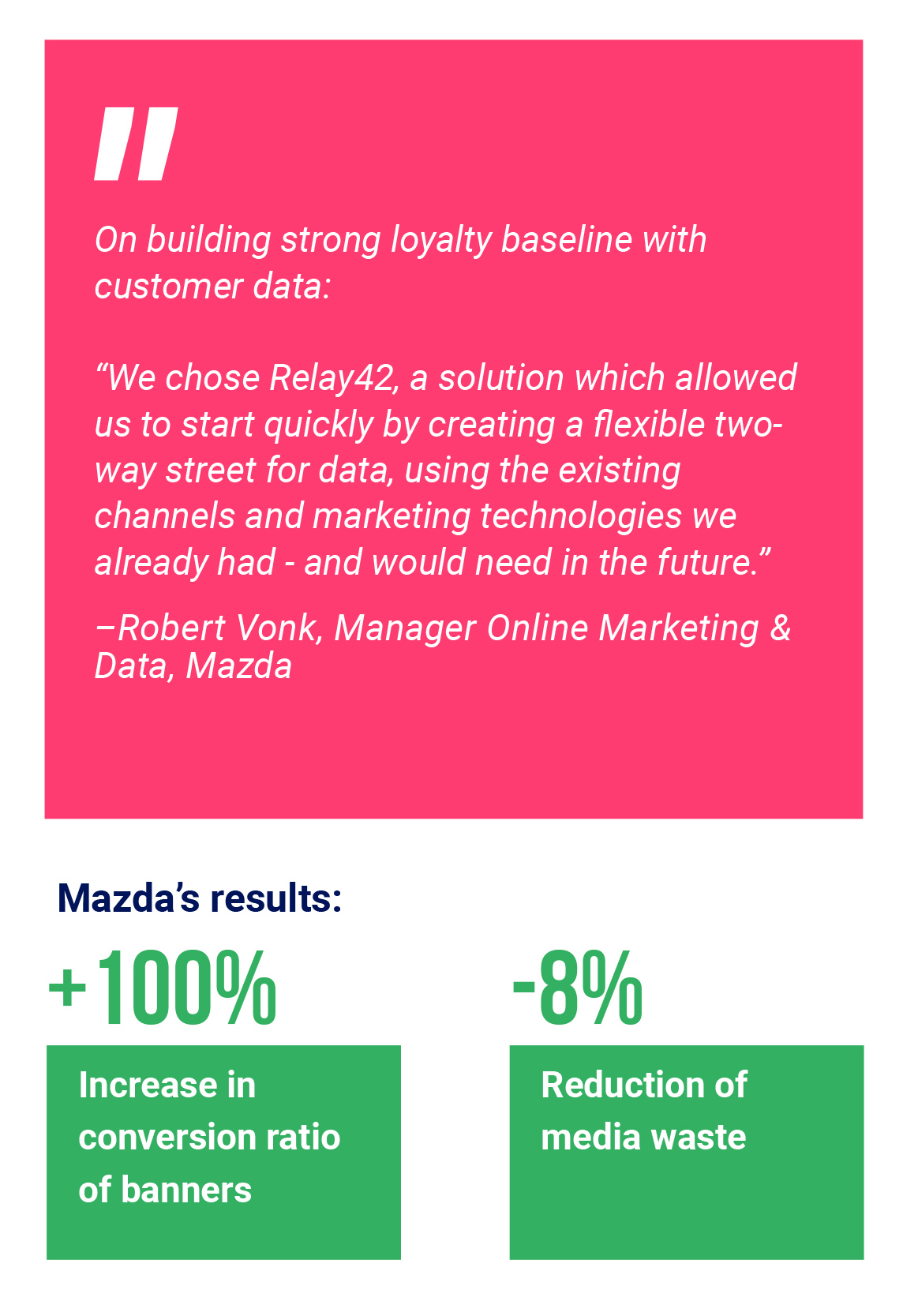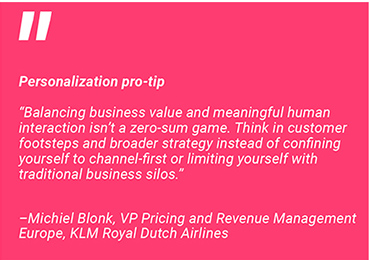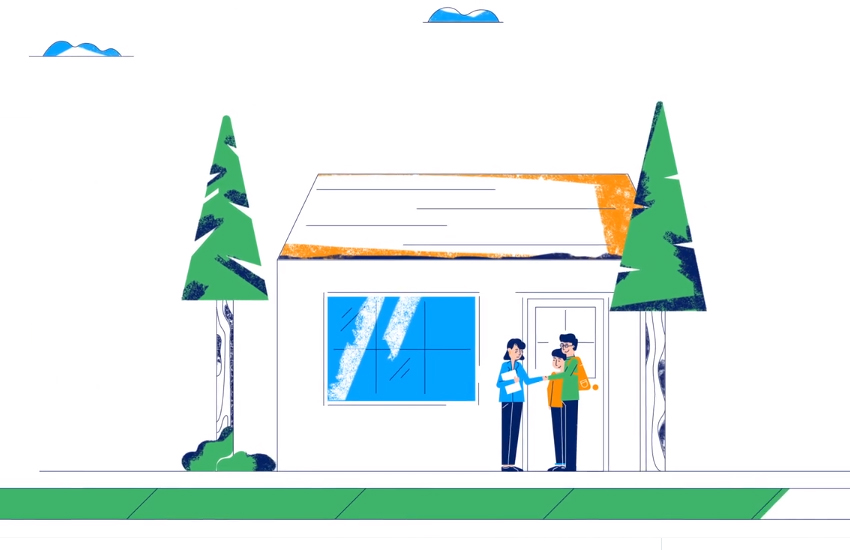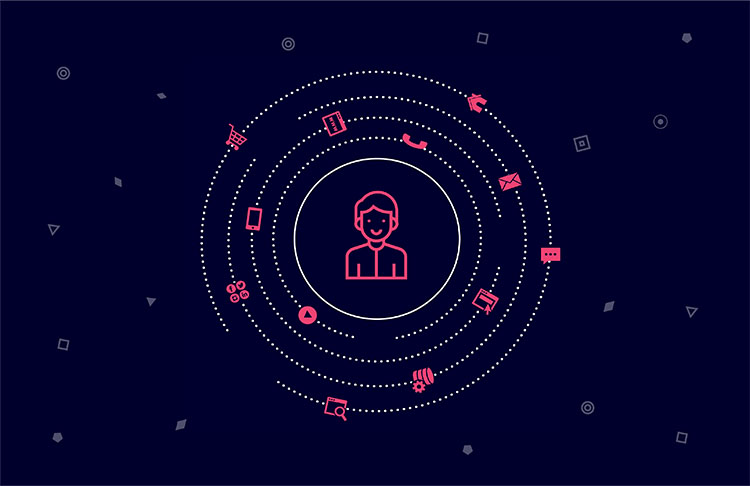EBOOK

TABLE OF CONTENTS
- Love your customers and they’ll love you back
- Three killer personalization myths
- Build recognition and trust
- Mirror your customer in context
- Add ‘smart’ to scale personalization
- Bad habits die hard — be the first to do better with personalization
Love your customers and they’ll love you back
We’ve reached a global point of inflection for customer experience. Moving beyond an obsession with ‘digital-only’ marketing and service, our business models are now mature enough to make the most of online and offline interaction points in a way that makes sense to customers.
So why are some companies getting it so wrong? Here are a few misleading myths surrounding personalization.
Personalization is a continuum, and most companies are somewhere along that path. But as the technology behind personalization has changed so drastically, so too have customer perceptions of what а ‘good’ experience should look like. Of course, tailoring email templates is the start of that journey; but customers
Love your customers and they’ll love you back
Personalization has changed for customers, but most companies missed the memo. CX custodians and digital connoisseurs have hit a glass ceiling when it comes to creating comprehensive, just-for-you customer journeys.
Why? For all their creative communication threads across audience-based targeting, smart outreach ideas on Facebook news feeds, and customer-centric growth hacks using look-a-like segmentation, the businesses they work with are still obsessing over a siloed world of digital transformation, rather than customer-led strategies. And with only 5% of organizations mastering their digital strategies to a point of differentiation from their competitors, there is work to be done and an emerging age of marketers to be empowered.
As fickle as today’s customers famously are, they also love convenience, reward, and excellence. This means feeling known, and being known, on a deeper level than first-name basis. It means experiencing service as more than being added to a basket of fellow ‘Barcelona-lovers’ or ‘first-time home buyers’ for digital campaigns.
Rather than focusing on these audience-based assumptions as a strategy for customer experience, it’s time for us to zoom in on the individual to deliver on each of their unique experiences with companies — one-to-one. Outstanding personalization is achievable now, whichever path your customer decides to take, and it makes a big difference to the way businesses both deliver and generate value.
It’s time to give customers exactly what they’re looking for, by building on the data they share with you every day.
In this eBook, we’ll help you to game the system of generalized CX to start delivering from your customer’s perspective, through smarter use of the data you already have:
-
Killer assumptions of personalization
-
Understand and avoid the common ways that businesses are damaging their customer relationships, through bad — or outdated — personalization.
-
Build for recognition and trust
-
Quickly create a baseline of trust by connecting one-to-one customer data exchanges and their interactions across owned, then external channels and audiences.
-
Mirror your customer in context
-
Truly understand and execute relevant customer journeys using intelligent any-channel orchestration of insights and content to go beyond [first-name] personalization at just the right moment.
-
Then add ‘smart’ to scale your personalization
Join market leaders in scaling each moment of interaction with Intelligent Journey Orchestration, using technology that allows you to automate these exchanges en masse so you can grow your return on investment and focus on a future-proof CX strategy.
1. Three killer personalization myths
We’ve reached a global point of inflection for customer experience. Moving beyond an obsession with ‘digital-only’ marketing and service, our business models are now mature enough to make the most of online and offline interaction points in a way that makes sense to customers.
So why are some companies getting it so wrong? Here are a few misleading myths surrounding personalization.
Myth 1) ‘Personalization is using a customer’s first name as the subject line of an email blast, then retargeting them until they convert.’
Personalization is a continuum, and most companies are somewhere along that path. But as the technology behind personalization has changed so drastically, so too have customer perceptions of what а ‘good’ experience should look like. Of course, tailoring email templates is the start of that journey; but customers expect you to create a baseline of one-to-one familiarity across every touchpoint.
Myth 2) ‘Customers don’t want ‘personalization’ anyway. That’s what the GDPR points to.’
A proliferation of bad digital advertising practices has meant that consumers understandably want to own and regain control of their journeys and their data. Good personalization shouldn’t intrude or come across as creepy. After all, no one ever said ‘I hate convenient end-to-end service experiences, catered to what I need.’ That’s why now more than ever, companies need to let their customers lead, and be ready to follow.
Myth 3) ‘Persona = personalization. I already know what my customer wants.’
Don’t mistake assumptions for knowledge. By using lookalike modeling and audience buying to underpin digital marketing activities, companies are inadvertently building on false positives by association, using a single attribute as a basis for their whole campaign. Truly effective personalization stems from data given straight from the customer themselves. It uses these customer data points as a foundation for outreach, building on what is true to scale customer certainties instead of best guesses.
2. Build recognition and trust
Personalizing for current and future customers
Building trust starts with recognizing who your customers are. And that means connecting a few key channels and implementing some basic logic between touchpoints.
Oft-burned, today’s customers are naturally going to be wary of your personalization efforts. Before you can personalize for the next ‘sell,’ establish a baseline of trust by creating value based on the data they share with you. Start with the basics of recognizing who is already a customer and who isn’t.
By starting with a simple statement like ‘not everyone who visits our website wants to buy ‘x’ product,’ you can use a data-driven marketing platform specializing in 1st party data to help differentiate between existing loyal customers and potential future customers.

If they’re already a customer of yours?
Stop sticking to their sidebar as they read their morning news. They’re already yours, and they should be treated as such.
By securely cross-pollinating customer data between core channels like CRM, website and display ads, you can become an explorer of whole new territories of the trust economy. Reward your customers with a product or message matching their lifecycle stage and create simple but genuine spheres of value.
Your customers will in turn reward you for creating this foundation of trust.
How Mazda Doubled their marketing effectiveness
Personalization pro-tip
Start building trust with your customers by simple differentiation of who they really are across a couple of core channels. Are they a current customer? Switch that display ad out for a one-to-one message that offers just-for-them value, via email for example.
3. Mirror your customer in context
Think and act in journeys, not one-off interactions
Simple exclusion of current customers from digital campaigns is just the start of your new personalization strategy. With orchestration capabilities in place, your team can start to plan — and act — in real-life customer journeys.
Take buying a house for example. How can you help your high-value customer — a first-time home buyer — achieve their aspirations by helping to align their goals with their savings?
This is about a bigger picture than managing money and insurance premiums. By beginning with their own customer data to know them better, you can anticipate their actions and mirroring their movements across channels. Instead of working in data silos, you can design a series of steps across partners, channels, and preferred products to build a journey that truly makes sense.

As your future customer is searching for a mortgage broker, planning for a new home, and worrying about their financial future, you are ready with a one-to-one message to offer a complimentary consultation, as well as a savings account with a fixed fee, so they needn’t worry about fluctuating interest rates.
You can even add nuances to the journey by altering the channel, sequencing, and frequency of each piece of outreach, depending on the level of urgency or their level of engagement. Regularly send valuable emails to hand over important long-term details in a closed environment and on an individual basis. Replace the email with a mobile push notification if they’re more invested. It’s the perfect way to remind them about their pending appointment and inspire greater urgency to act. Then, take her open rate and interactions into consideration the next time around.
When you create shortcuts for customers by connecting their history with their future choices, your business can create comprehensive journeys for each valuable customer. Your customers can browse, compare, consider — pause — then continue their experience where they left off, whether it’s via a reminder email or a personalized web banner. This is how personalization works on a deeper level.
Ready to scale your customer experience?
Here's how to move from blasting large audiences to taking a personalized, data-driven approach, in 3 steps:
Infographic: 3 steps to omnichannel customer journeys
4. Add ‘smart’ to scale personalization
Turn single interactions into a symphony of customer relevance
Now that you have a foundation of high-quality data and direct intent to play with, you are ready to take your personalization a level further still.
You are ready to bring your customer data strategy from one-to-one, to one-to-many?
We already know the answer to better personalization is to cater to unique customers rather than focusing on single attributes or individual channel performance. But with this baseline in place, you can add other data sources into your targeting from all your preferred technologies — within one hub. You can use the golden overlap between your existing database — those who have interacted with you before — and a pool of external behavioral data to predict and confirm their interest.
This allows you to anticipate a niche customer segment for a super-personalized campaign based on concrete actions, not best guesses. By using cross-channel orchestration to ingest and apply your customers’ preferences across online search, email, website, mobile, display, and more, you are using their intent data to strengthen your personalization efforts. You are turning predictive programming into near-certainty in real-time.
With this strong baseline in customer data, can you begin using artificial intelligence to power your predictions and anticipate the movements of individuals based on the footsteps they’ve taken before?
 Personalization with Journey Orchestration
Personalization with Journey Orchestration
The Relay42 platform works to powerfully enrich your customer journeys by activating your customer data, then adding a layer of intelligence to scale these experiences across new frontiers of value. It helps you underpin quality customer data by principle and by design, so you can easily augment your customer campaigns with audiences from traceable sources to predict next-best-actions and otherwise unseen CX decisions.
By starting small with what you already have, Intelligent Journey Orchestration can help you personalize on a deeper level and across a growing landscape of owned channels and external media. It’s the path that’s leading future-forward companies to the next generation of customer loyalty.
Bad habits die hard — be the first to do better with personalization
Technology has the power to create empathy. It gives businesses the ability to pay attention, respond to direct data signals and grow a one-to-one conversational approach into the millions. It allows your customers to feel truly heard. You have the opportunity to open up new pathways to make your customers happy by creating better journeys to where they’re going, while simultaneously ensuring your business ROI feels the direct benefit of customer delight.
This level of layered, customer-led personalization creates an opportunity for companies to get ahead and differentiate from fast-moving competition.
Is it a nice-to-have? No, it’s essential. By getting ahead, marketing and CX industry shakers can move beyond doing the bare minimum to survive, and instead, they can thrive. Teams using Intelligent Journey Orchestration can surprise a straying customer and inspire them to stay through better service.
It’s time to take personalization beyond something that sits on the surface. It’s time to go deeper, by mirroring, then anticipating what a customer wants and needs, across any business silo and across every customer screen.
Would you like to experience the Relay42 Platform?
Request a demo


